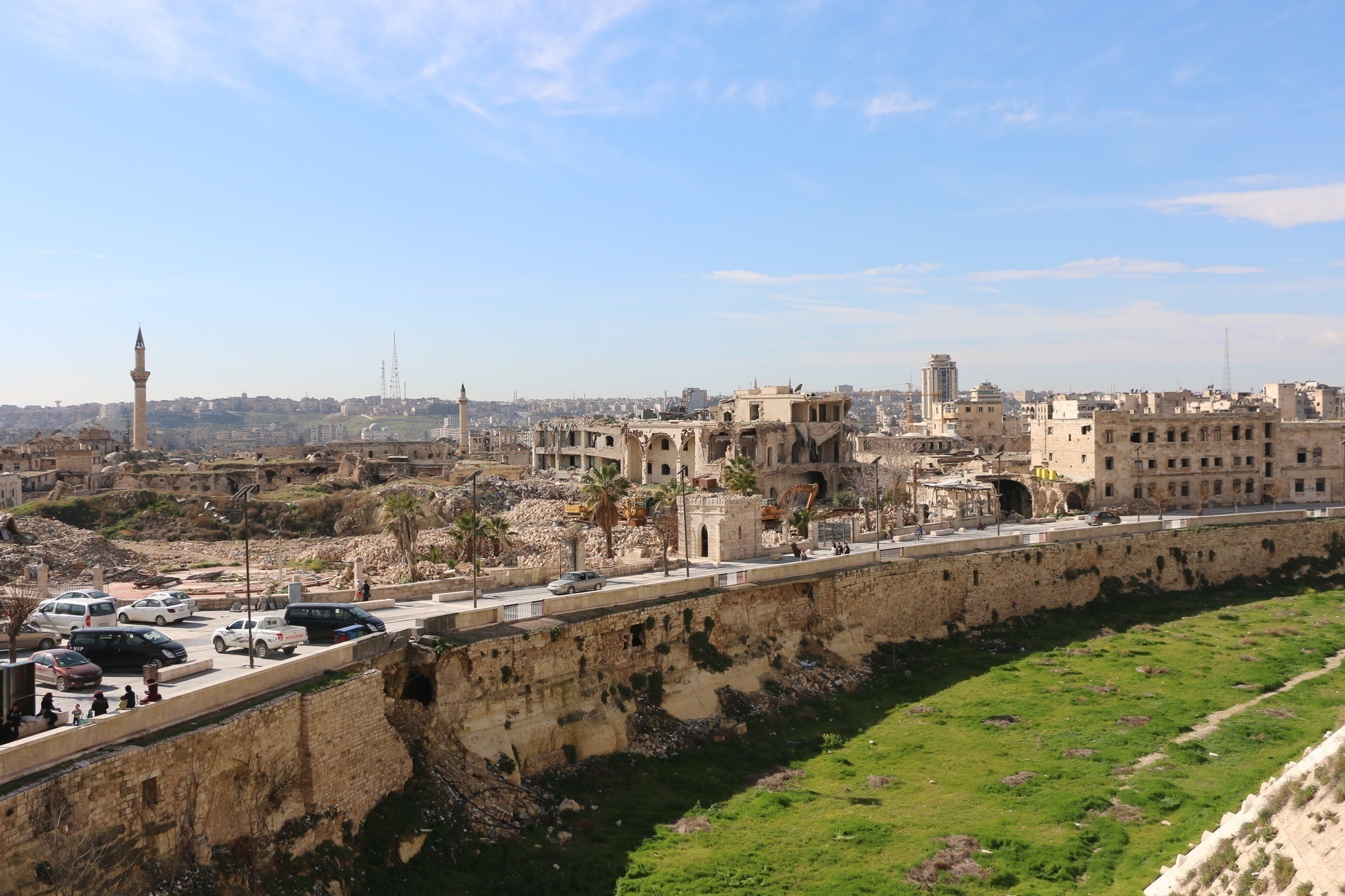The Syrian Peace Process

Syria has been a near constant presence in global news for several years. As fighting and violence in the area fluctuates and news cycles are routinely hit with shocking graphics and waves of new information, it can be difficult to discern what exactly is happening in the area, and what is being done in an attempt to quell the violence. Since the start of the conflict, the situation has grown more complicated, involving many actors with varying agendas: a number of fractured opposition groups, IS and Nusra Front (an Al-Qaeda affiliate), and foreign governments such as Russia, Iran, U.S. Turkey, Saudi Arabia, Qatar, etc. Although there is no simple or linear timeline of the situation in Syria, several key events, triggered by the 2011 Arab Spring, offer a brief outline of the change that has occurred in the area within the past decade.[i]
Starting in February 2011, a number of non-violent political protests, linked to the Arab Spring movement, were carried out against the Syrian government. In response, Syrian government security forces began imprisoning and shooting protestors.[ii] Violent unrest steadily increased between protestors and government forces. By July 2011, a group of defectors from the Syrian military formed the Free Syrian Army (FSA), one of many opposition forces to be formed against the government.[iii] By November 2011, the Arab League, an intergovernmental organization of Arab-speaking Middle Eastern and African nations, voted to suspend Syria’s membership and place sanctions on the government because of its failure to implement a peace plan.[iv] In early 2012, the Syrian government increased its bombardment of Homs and other cities.[v]
Amid escalating violence in February 2012, Kofi Annan was appointed joint UN and Arab League peace envoy for Syria. He submitted a non-binding peace plan to the UN Security Council in March, calling on the Syrian government to end violence against the opposition and for both sides to accept a cease-fire.[vi] The plan was accepted by all 15 members of the Security Council; however, despite the resolution, violence continued. Ban Ki-Moon, the secretary general of the United Nations, released a statement acknowledging that both the Syrian government and opposition forces were responsible for violating the cease-fire.[vii] In July 2012, the International Committee of the Red Cross classified the situation in Syria as that of a civil war.[viii]
By January 2013, Syria accused Israel of bombing near one of its military research facilities where unofficial reports suggest that Hezbollah, a Lebanese armed group which has stockpiled weapons in Syria, had assembled a weapons convoy bound for Lebanon.[ix] Since the start of the Syrian civil war, Hezbollah and the Iranian Revolutionary Guard Corps have supported the Assad government in key battles in Aleppo, Deir-ez Zor, and Der’ra.[x]
Soon in 2013, reports of chemical attacks in Syria surfaced. By September, UN inspectors confirmed that chemical weapons had been used on a large scale in the attacks on August 21 in a town near Aleppo, but allegations as to who deployed the chemical agents remain inconclusive.[xi] In December, the United States, United Kingdom, France, Turkey and the Gulf States recognized the opposition party—the National Coalition—as the legitimate representative of the Syrian people, defying the current Assad government.[xii] In early 2014, the UN attempted to broker peace talks in Geneva in the hopes of ending the Syrian Civil War by bringing together the Syrian government and the opposition parties.[xiii] The talks failed, however, and the conference yielded no tangible results or resolutions. During the nine days of the conference, the Syrian Observatory for Human Rights reported that over 1,800 people had died in Syria.[xiv]
In June 2014, the Islamic State of Iraq and the Levant (ISIL) changed its name to the broader Islamic State (IS) and claimed caliphate over the region from Aleppo, Syria to Diyala, Iraq.[xv] The United States and a coalition of Arab nations increased their air strike campaign against IS targets in Syria and Iraq.[xvi] Russia intervened in the following year, executing its own airstrikes in Syria, backing the Syrian government. In March 2016, the Syrian government with Russian air assistance retook Palmyra from IS.[xvii] In 2016, Syrian government troops backed by Russia and Iran recaptured Aleppo, which rebels had been using as a stronghold.[xviii]
In January 2017, Russia, Iran, and Turkey met in Kazakhstan and agreed to enforce a ceasefire between the Assad government and rebel groups. President Trump ordered a missile attack on an airbase in April where Syrian government planes had allegedly launched a chemical weapons attack.[xix] By October 2017, IS was driven from its strongholds in Raqqa and Deir al-Zour[xx] which spurred President Putin to visit Syria near the end of year to declare victory against IS.[xxi] Despite Putin’s claim, IS continued to operate within Syria.
In 2018 Turkey launched an assault on Northern Syria to oust Kurdish rebels controlling Afrin.[xxii] Turkey, since the beginning of the war, has supported opposition forces and funded non-Kurdish factions in the Syrian opposition.[xxiii] In addition, as part of the US-led coalition against IS, Turkey has conducted airstrike attacks against IS targets in Syria.[xxiv] Ultimately, Turkey seeks to prevent Syrian Kurds from territorial gains in the country.
By July 2018, the Syrian army recaptured most of the south of Syria, up to the borders with Jordan and Israeli-held territory.[xxv] Ghouta was sieged by a second deadly chemical attack, for which neither the government nor rebel groups claimed responsibility.[xxvi] Reports of chemical attacks continue.
Involvement of the United Nations
As early as 2011, the United Nations Human Rights Council (OHCHR) began to discuss the situation in Syria and as such, established the Commission of Inquiry on Syria to monitor gross violations of human rights. Shortly after, the UN released several resolutions addressing the violence in Syria, and the Security Council began discussing measures such as arms embargoes and targeted sanctions. While the UN-led peace process has emphasized a political transition, the Astana talks have focused more on the de-escalation of violence.[xxvii] The Astana talks, spearheaded by Russia, Turkey, and Iran, began in 2017 and have gradually eclipsed the UN-sponsored peace talks. In January 2017, the talks brought rebel and government representatives to Astana, the capital of Kazakhstan, to begin negotiations for a cease-fire. Little progress was made, but in May 2017, Russia, Turkey, and Iran adopted a plan to create four de-escalation zones within Syria. However, since the start of 2018, the Syrian government, backed by Russia, has overtaken three of the four zones, largely through heavy bombardment which led to the surrender of rebel force.[xxviii] There still remain discussions over the formation of a constitutional committee which is meant to reform the constitution and pave a way for elections in Syria.[xxix]
As these peace talks and advocacy efforts press forward at varying speeds, the UN has been working to get immediate humanitarian assistance into and around areas of Syria that desperately need it: areas such as the Rukban camp which lies in the no man’s land near the shared border of Syria, Jordan and Iraq.[xxx] In February 2019, the UN finally succeeded in reaching Rukban.[xxxi] The accessibility of humanitarian relief consistently circles back to the need for aid to transcend borders regardless of the widespread political rhetoric.[xxxii]
The situation in Syria is very complex, and international conflicts contain neither simple questions nor simple answers. The conflicts themselves and the peace efforts undertaken by bodies like the UN must be considered within the nuance of the environments that created them.
Victoria Wiebe is a Program Assistant at the Mennonite Central Committee United Nations Office.
Abby Hershberger is a Program Assistant and the Communications Coordinator at the Mennonite Central Committee United Nations Office.
Senéad Short is a Program Assistant with Mennonite Central Committee in Beirut, Lebanon.
Sources
[i] Aljazeera, Syria’s civil war explained from the beginning, April 2018.
[ii] Encyclopedia Britannica, Uprising in Syria- 2011.
[iii] Ibid.
[iv] The Guardian, Syria suspended from Arab League, November 12, 2011.
[v] BBC, Syria Profile: Timeline, January 14, 2019.
[vi] Encyclopedia Britannica, Uprising in Syria- 2011.
[vii] Ibid.
[viii] Ibid.
[ix] BBC, Syria Profile: Timeline, January 14, 2019.
[x] Center for Strategic and International Studies, Idlib Province and the Future of Stability in Syria, September 21, 2018.
[xi] Encyclopedia Britannica, Uprising in Syria- 2011.
[xii] BBC, Syria Profile: Timeline, January 14, 2019.
[xiii] Ibid.
[xiv] Daily Star, At Least 1,870 Die During Geneva Talks, February 1, 2014.
[xv] BBC, Syria Profile: Timeline, January 14, 2019.
[xvi] Encyclopedia Britannica, Uprising in Syria- 2011.
[xvii] BBC, Syria Profile: Timeline, January 14, 2019.
[xviii] Ibid.
[xix] Ibid.
[xx] Ibid.
[xxii] Ibid.
[xxiii] Deutsche Welle, Syria Conflict: What do the U.S., Russia, Turkey, and Iran want? January 23, 2019.
[xxiv] Ibid.
[xxv] Ibid.
[xxvi] BBC, Syria war: What we know about Douma ‘chemical attack’, July, 2018.
[xxvii] France 224, Syria: The Astana peace process, September 2018.
[xxviii] Ibid.
[xxx] Aljazeera, Rukban Camp in Syria receives first aid in three months, February 2018
[xxxi] Ibid.
[xxxii] UN News, Humanitarian aid convoy’s to Syria’s Rukban: Mission Accomplished, November 2018.

